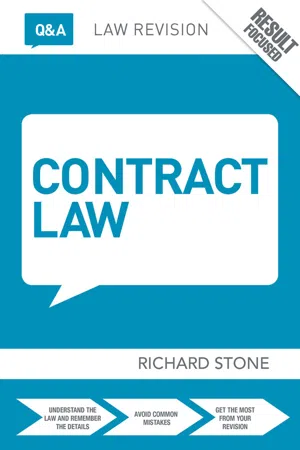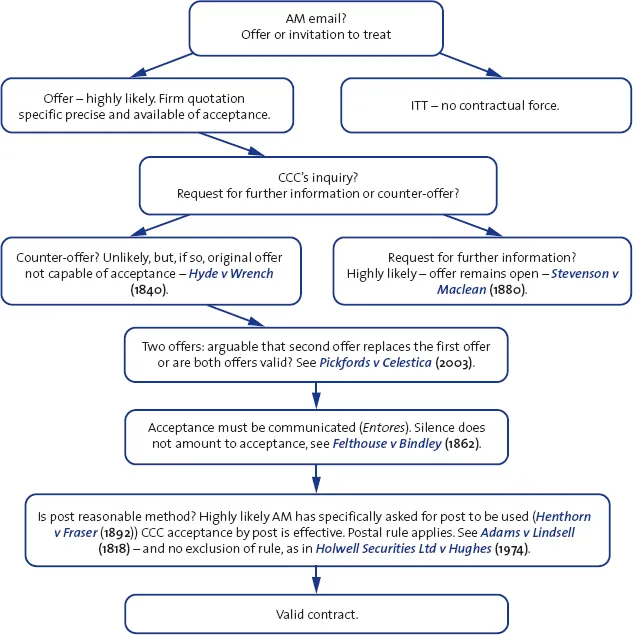
- 208 pages
- English
- ePUB (mobile friendly)
- Available on iOS & Android
eBook - ePub
Q&A Contract Law
About this book
Routledge Q&As give you the tools to practice and refine your exam technique, showing you how to apply your knowledge to maximum effect in an exam situation.
Each book contains essay and problem-based questions on the most commonly examined topics, complete with expert guidance and fully worked model answers that help you to:
-
- Plan your revision:
-
-
- introducing how best to approach revision in each subject
-
-
- Know what examiners are looking for:
-
-
- identifying and explaining the main elements of each question to help you understand the best approach
-
- providing marker annotation to show how examiners will read your answer
-
-
- Gain marks, and avoid common errors:
-
-
- identifying common pitfalls students encounter in class and in assessment
-
- providing revision advice to help you aim higher in essays and exams
-
-
- Understand and remember the law:
-
-
- using diagrams as overviews for each answer to demonstrate how the law fits together
-
The series is also supported by an online resource that allows you to test your progress during the run-up to exams. Features include: multiple choice questions, bonus Q&As and podcasts.
www.routledge.com/cw/revision
Frequently asked questions
Yes, you can cancel anytime from the Subscription tab in your account settings on the Perlego website. Your subscription will stay active until the end of your current billing period. Learn how to cancel your subscription.
No, books cannot be downloaded as external files, such as PDFs, for use outside of Perlego. However, you can download books within the Perlego app for offline reading on mobile or tablet. Learn more here.
Perlego offers two plans: Essential and Complete
- Essential is ideal for learners and professionals who enjoy exploring a wide range of subjects. Access the Essential Library with 800,000+ trusted titles and best-sellers across business, personal growth, and the humanities. Includes unlimited reading time and Standard Read Aloud voice.
- Complete: Perfect for advanced learners and researchers needing full, unrestricted access. Unlock 1.4M+ books across hundreds of subjects, including academic and specialized titles. The Complete Plan also includes advanced features like Premium Read Aloud and Research Assistant.
We are an online textbook subscription service, where you can get access to an entire online library for less than the price of a single book per month. With over 1 million books across 1000+ topics, we’ve got you covered! Learn more here.
Look out for the read-aloud symbol on your next book to see if you can listen to it. The read-aloud tool reads text aloud for you, highlighting the text as it is being read. You can pause it, speed it up and slow it down. Learn more here.
Yes! You can use the Perlego app on both iOS or Android devices to read anytime, anywhere — even offline. Perfect for commutes or when you’re on the go.
Please note we cannot support devices running on iOS 13 and Android 7 or earlier. Learn more about using the app.
Please note we cannot support devices running on iOS 13 and Android 7 or earlier. Learn more about using the app.
Yes, you can access Q&A Contract Law by Richard Stone in PDF and/or ePUB format, as well as other popular books in Law & Contract Law. We have over one million books available in our catalogue for you to explore.
Information
1 | Offer and Acceptance |
INTRODUCTION
There can be few contract exam papers which do not contain a question on offer and acceptance. Students will often make this one of their ‘banker’ questions, but you will need to make sure that you are prepared to deal with any of the forms in which a question about offer and acceptance may be asked. The topics covered within this general heading are quite varied, but are nevertheless fairly predictable. General issues that will need to be understood include:
1. The nature of an offer and an acceptance – is an advertisement an offer? What if an ‘acceptance’ does not match the offer precisely? What is the effect of a ‘counter-offer’?
2. The relationship between offer and acceptance on the one hand and ‘agreement’ on the other – the objective approach to determining the existence of a contract.
3. The differences between unilateral and bilateral contracts.
As will be seen from the questions in this chapter, problems concerning the communication of offer and acceptance are often asked. In particular, students will need to be familiar with:




Finally, it should be remembered that a question involving offer and acceptance may also sometimes require you to touch on other issues. You may find, for example, that an offer and acceptance question (although this is not the case with those contained in this chapter) will also involve discussion of intention to create legal relations, consideration or mistake.
Checklist
You should be familiar with the following areas:
■ the meaning of offer – the distinction from an ‘invitation to treat’;
■ the meaning of acceptance – the distinction from a ‘counter-offer’, and the possibility of acceptance by conduct or silence;
■ the differences between unilateral and bilateral contracts;
■ the postal rule and its limitations;
■ revocation of offers; and
■ recall of acceptance.
QUESTION 1 ----------------------------------------
Abel Movers plc and Cain Construction Co Ltd have been in negotiations over a contract to move a large quantity of equipment owned by CCC, and currently stored in a warehouse, to its main premises. CCC asks for a quote for this work to be carried out over a weekend. On 30 May AM sends CCC an email quoting a price of £15,000 to complete the work over a Saturday and Sunday. CCC replies asking what the difference in price would be if the work was carried out over a longer period during weekdays. AM sends a second email on 31 May quoting a price of £12,000 to spread the work over four days during the week. Both AM’s emails have an order form attached, and state ‘If you wish to accept this quotation, please print off and sign the attached order form and return it to us by post.’ When CCC reads the second email, on the morning of 1 June, it decides at once that the difference in price is insufficient to be worth the greater disruption of having the work done during the week. It immediately prints off the order form attached to the first email, signs it and posts it to AM. Meanwhile, AM has realised that it has underestimated the costs of doing the work over the weekend, and that it should have quoted a price of £20,000. On 2 June it sends an email to CCC stating ‘This is to confirm that, following our quotation of 31 May, the quotation in our email of 30 May is no longer available for acceptance.’ On 3 June CCC’s signed form is received by AM.

How to Read this Question
In reading a question it is important to be clear as to what the examiner is asking you to do. In this question, the instruction is to examine whether a contract has been made, and if so on what terms. The elements of a contract are offer, acceptance, consideration and intention. A quick read of the facts should tell you that there are no real issues of consideration or intention here. So your focus will be almost exclusively on offer and acceptance. The issue as to the terms is related to that of the offer and acceptance, since the answer depends on whose offer has been accepted.
How to Answer this Question
This question is of a common type, raising issues about the communication of offers and acceptances, and which of two parties is entitled to enforce a contract. In answering such a question, in which the timing of events may be very important, it is a good idea to make a chronological plan – for example:
1. 30 May – first offer from AM (email).
2. 30 May – request for information from CCC.
3. 31 May – second offer from AM (email).
4. 1 June – acceptance of first offer posted by CCC.
5. 2 June – withdrawal of first offer by AM (email).
6. 3 June – CCC’s acceptance of first offer received by AM.
This should make it easier to pinpoint the issues for discussion. Particular areas to be considered here are: offers, counter-offers and requests for information; the operation of the postal rule (Adams v Lindsell (1818)); and the revocation of offers. This problem raises the issue of whether there is a matching offer and acceptance, so that a contract has been made, and if so on what terms. The answer to this will depend on the point at which communications between the parties take effect, particularly acceptances and revocations of offers.
Applying the Law

This diagram highlights the main issues to consider in your answer.
ANSWER ----------------------------------------
The English law on the formation of contracts generally requires there to be an offer and a matching acceptance. This is particularly the case with contracts made by correspondence, whether by letter, fax or email. The offer must set out, or refer to, all of the important terms of the contract; the acceptance must indicate agreement to all these. If it does not do so, not only will it not be a valid acceptance, but it will be regarded as a counter-offer, which prevents the original offer from being accepted later (Hyde v Wrench (1840)). An offer can generally be withdrawn at any time before acceptance is complete (Payne v Cave (1789)).
In this case there has been an exchange of emails between AM and CCC, and a letter sent by CCC to AM. The question is whether these exchanges have ended up with a contract being formed, and if so on what terms?
The first communication to consider is AM’s email of 30 May. Is this an offer, or an invitation to treat? A communication will be an offer if it is apparently intended by the person sending it that they will be bound to a contract if the addressee simply says ‘yes, I accept’. It...
Table of contents
- Cover
- Half Title
- Title Page
- Copyright Page
- Table of Contents
- Table of Cases
- Table of Legislation
- Guide to the Companion Website
- Introduction
- 1 Offer and Acceptance
- 2 Intention and Consideration
- 3 Privity
- 4 Contents of the Contract
- 5 Exclusion Clauses
- 6 Mistake and Misrepresentation
- 7 Duress and Undue Influence
- 8 Illegality
- 9 Frustration
- 10 Performance and Breach
- 11 Remedies
- Index